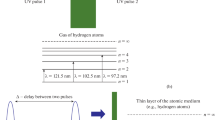Abstract
Spatial hole burning of population differences by standing waves is considered in terms of Bragg-like gratings. This philosophy is used to explain increased saturation in two-mirror, single-mode laser operation with stationary active systems, modified mode coupling in the corresponding two-mode operation, an intensity dip that might occur in flowed standing wave lasers, bistable unidirectional ring laser operation, and increased saturation in distributed feedback lasers. The analysis is developed for both stationary media and for those moving with respect to the standing wave. The latter treatment is used to interpret washout of grating contributions in Doppler broadened media, and to determine level decay constants in stationary media. This last application constitutes a stationary system analog to the Doppler medium's Lamb dip spectroscopy and can be called saturation grating spectroscopy. Knowledge of the decay constants is particularly important in laser studies involving coherent mode couplings such as due to saturation grating scattering and population pulsations. It is further shown that the same equations result for probe and saturating waves propagating in the same direction. One then obtains a signal absorption with a heterodyne advantage. Inasmuch as diffusion affects the two methods quite differently, this phenomenon should be easily examined.
Similar content being viewed by others
References
C. L. Tang, H. Statz, G. DeMars: J. Appl. Phys.34, 2289 (1963);
H. Haken, H. Sauermann: Z. Physik173, 261 (1963)
J. Hambenne, M. Sargent III: IEEE J. Quant. Electr. QE-11, 90 (1975) The effect was derived without the grating interpretation by J. A. White, Phys. Rev.137, A1651 (1965); S. G. Zeiger, E. E. Fradkin, Opt. Spektr.21, 386 (1966); and by K. Takata: Jap. J. Appl. Phys.11, 699 (1972).
G. Marowsky and K. Kaufmann (IEEE J. Quantum Electron. to be published) have observed a counterexample to the bistable, unidirectionality, perhaps explainable by appearance of cavity anisotropy
J. A. White: Nature20, 911 (1964)
H. G. Danielmeyer: J. Appl. Phys.42, 3125 (1971)
M. Sargent III: InApplications of lasers to atomic and molecular physics, Les Houches summer school, ed. by R. Balian and S. Haroche (North-Holland Pub. Co., Amsterdam 1976). Much of the material in the present paper is motivated in these lectures
The idea that saturation gratings might be useful for spectroscopy developed in stimulating conversations with R. Brewer, W. Fairbank, and especially with F. Keilmann to whom the author is very grateful
M. Sargent III, M. O. Scully, W. E. Lamb, Jr.:Laser Physics (Addison-Wesley Pub. Co., Reading, Mass. 1974)
H. G. Danielmeyer, M. Sargent III, P. Toschek: To be published. E. V. Baklanov and V. P. Chebotaev have applied the corunning case to Doppler broadened media (Op. Cit. Ref. 9)
See, for example, P. W. Smith, T. W. Hänsch: Phys. Rev. Letters26, 740 (1971), T. W. Hänsch, I. S. Shahin, A. L. Schawlow, Phys. Rev. Letters27, 707 (1971). For theory see S. Haroche, F. Hartmann: Phys. Rev. A6, 1280 (1972); and E. V. Baklanov, V. P. Chebotaev: Soviet Phys. JETP34, 490 (1972). A general review has been given by P. Toschek: Colloques Internationaux des C.N.R.S., No.217, 13 (1973)
Coherent saturation phenomena are well known in three level spectroscopy; see reviews by M.Feld, P.Toschek: In Les Housches proceedings, op. cit. ed. by
H. Eichler, P. Glozbach, B. Kluzowski: Z. Angew. Physik28, 303 (1970); see also H. Eichler, H. Stahl: J. Appl. Phys.44, 3429 (1973);44, 5383 (1973); and H. J. Eichler, J. Eichler: J. Appl. Phys.45, 4950 (1974). W. Rother, H. Meyer, W. Kaiser (Z. Naturforsch.25a, 1136 (1970)) studied what one might call thermal gratings with a method very much like the grating dip spectroscopy of Sect. 5
H. G. Danielmeyer: J. Appl. Phys.41, 4014 (1970); H. G. Danielmeyer, W. G. Nilsen; Appl. Phys. Letters16, 124 (1970); and H. G. Danielmeyer, E. H. Turner: Appl. Phys. Letters17, 519 (1970)
J. Hambenne, M. Sargent III: Phys. Rev. A (1976)
L. N. Menegozzi, W. E. Lamb, Jr.: Phys. Rev. A8, 2103 (1973); see also K. Tanaka, op. cit. [2]
S. Stenholm, W. E. Lamb, Jr.: Phys. Rev.181, 618 (1969)
W. E. Lamb, Jr.: Phys. Rev.134, A1429 (1964)
K. M. Evenson, F. R. Peterson: InLaser Applications to Optics and Spectroscopy, ed. by S. F. Jacobs, M. Sargent III, J. F. Scott, and M. O. Scully (Addison-Wesley Publ. Comp., Reading, Mass. 1975)
H. Kogelnik, C. V. Shank: J. Appl. Phys.43, 2327 (1972); see also A. Yariv,Quantum Electronics (John Wiley and Sons, New York 1975) Sect. 19.6
I. S. Gradshteyn, I. M. Ryzhik:Table of Integrals, Series, and Products (Academic Press, New York 1965) p. 149
C. V. Shank, J. E. Bjorkholm, H. Kogelnik: Appl. Phys. Letters18, 395 (1971)
K. O. Hill, A. Watanabe: Appl. Opt.14, 950 (1975)
H. G. Danielmeyer: InFestkörperprobleme, Vol. 15 (Advances in Solid State Physics15), ed. by H. J. Queisser, Pergamon/Vieweg, Braunschweig 1975) p. 253
M. Sargent III: To be published
Author information
Authors and Affiliations
Additional information
Work supported in part by a U.S. Senior Scientist Award (administered by the Alexander von Humboldt Stiftung) and in part by the Space and Missile Systems Organization, Los Angeles, California.
Rights and permissions
About this article
Cite this article
Sargent, M. Laser saturation grating phenomena. Appl. Phys. 9, 127–141 (1976). https://doi.org/10.1007/BF00903949
Received:
Accepted:
Issue Date:
DOI: https://doi.org/10.1007/BF00903949



